This chapter presents an updated global assessment of food insecurity and nutrition for up to the year 2021 and a report on progress towards meeting SDG Targets 2.1 and 2.2: ending hunger and ensuring access to safe, nutritious and sufficient food for all people all year round; and eradicating all forms of malnutrition.
The assessment in last year’s report of the situation in 2020 – the year the COVID-19 pandemic spread rapidly across the globe – revealed major setbacks, with growing numbers of people facing hunger and food insecurity as the unprecedented crisis exacerbated inequalities that were already stalling progress prior to the pandemic. It also highlighted that malnutrition in all its forms remains a challenge and that child malnutrition, in particular, is expected to be higher due to the effects of the pandemic.
Despite hopes that the world would emerge more quickly from the crisis and food security would begin to recover from the pandemic in 2021, the pandemic held its grip and even tightened it in some parts of the world. The rebound of gross domestic product (GDP) growth observed in most countries in 2021 did not translate into gains in food security in the same year. Enormous challenges are still faced by those who continue to be the most affected: those with less wealth, lower and more unstable incomes and poorer access to critical basic services. The COVID-19 pandemic increased inequalities between countries and within countries that the economic recovery has not yet been able to reverse.
Another crisis is unfolding as this report is being written with potentially sobering implications for global food security and nutrition: the war in Ukraine. Although the statistics presented in this report represent the state of food security and nutrition up until 2021, the direct and indirect effects of the conflict in 2022 will have multiple implications for global agricultural markets through the channels of trade, production and prices. Ultimately, this casts a shadow over the state of food security and nutrition for many countries, in particular those that are already facing hunger and food crisis situations, and poses an additional challenge for achieving the SDG 2 targets of ending hunger and ensuring access to adequate food for all (SDG Target 2.1) and of eliminating all forms of malnutrition (SDG Target 2.2).
Section 2.1 of this chapter presents an updated assessment of the state of food security and progress towards achieving the hunger and food insecurity targets (SDG 2.1). It includes global, regional and subregional assessments of the two SDG Target 2.1 indicators: the prevalence of undernourishment (PoU) and the prevalence of moderate or severe food insecurity based on the Food Insecurity Experience Scale (FIES), revised up to 2021 based on the most recent data available to FAO at the time of closing the production of this report. Updated projections of what the PoU may be in 2030 are also provided.
Section 2.2 presents analyses of the state of nutrition and progress towards the global nutrition targets defined by the World Health Assembly (WHA) in 2012 and the 2030 Agenda for Sustainable Development (SDG 2.2). While the COVID-19 pandemic interfered with the collection of data needed to update most of the nutrition indicators, the section sheds new light on the unequal distribution of malnutrition in the population and the groups most affected, based on the most recent estimates available. An analytical framework showing the pathways through which the COVID-19 pandemic may impact various forms of malnutrition is described, with two country-level analyses that provide clues as to what the new nutrition data may reveal about the consequences of the pandemic when they become available.
Section 2.3 presents updated estimates of the cost and affordability of a healthy diet, based on an improved methodology. These indicators shed light on one critical aspect of achieving healthy diets: access to diverse, nutritious foods.
2.1 Food security indicators – latest updates and progress towards ending hunger and ensuring food security
- ➔ Despite hopes that the world would emerge from the COVID-19 pandemic in 2021 and food security would begin to improve, world hunger rose further in 2021. After remaining relatively unchanged since 2015, the prevalence of undernourishment (PoU) jumped from 8.0 to 9.3 percent from 2019 to 2020 and rose at a slower pace in 2021 to 9.8 percent.
- ➔ It is estimated that between 702 and 828 million people were affected by hunger in 2021. The number has grown by about 150 million since the outbreak of the COVID-19 pandemic – 103 million more people between 2019 and 2020 and 46 million more in 2021, considering the middle of the projected range.
- ➔ The further increase in global hunger in 2021 reflects exacerbated inequalities across and within countries due to an unequal pattern of economic recovery among countries and unrecovered income losses among those most affected by the COVID-19 pandemic, all in a context of diminishing social protection measures that had been implemented in 2020.
- ➔ In 2021, hunger affected 278 million people in Africa, 425 million in Asia and 56.5 million in Latin America and the Caribbean – 20.2, 9.1 and 8.6 percent of the population, respectively. While most of the world’s undernourished people live in Asia, Africa is the region where the prevalence is highest.
- ➔ After increasing from 2019 to 2020 in most of Africa, Asia and Latin America and the Caribbean, hunger continued to rise in most subregions in 2021, but at a slower pace. Compared with 2019, the largest increase was observed in Africa, both in terms of percentage and number of people.
- ➔ It is estimated that nearly 670 million people will still be undernourished in 2030 – 8 percent of the world population, which is the same percentage as in 2015 when the 2030 Agenda was launched. This is 78 million more undernourished people in 2030 compared to a scenario in which the pandemic had not occurred.
- ➔ After increasing sharply in 2020, the global prevalence of moderate or severe food insecurity remained mostly unchanged in 2021, whereas that of severe food insecurity rose higher, providing additional evidence of a deteriorating situation mainly for people already facing serious hardships.
- ➔ Around 2.3 billion people in the world were moderately or severely food insecure in 2021, or nearly 30 percent of the global population – more than 350 million more people than in 2019, the year before the COVID-19 pandemic unfolded.
- ➔ Close to 40 percent of people affected by moderate or severe food insecurity in the world were facing food insecurity at severe levels. The prevalence of severe food insecurity increased from 9.3 percent in 2019 to 11.7 percent in 2021 – the equivalent of 207 million more people in two years.
- ➔ In the last year, moderate or severe food insecurity increased the most in Africa, the region with the highest prevalence at both levels of severity. Food security also continued to worsen in Latin America and the Caribbean, although at a slower pace compared to the year before. In Asia, the prevalence of moderate or severe food insecurity showed a slight decrease between 2020 and 2021, in spite of a small increase in severe food insecurity.
- ➔ The gender gap in food insecurity – which had grown in 2020 under the shadow of the COVID-19 pandemic – widened even further in 2021, driven largely by the widening differences in Latin America and the Caribbean, as well as in Asia. In 2021, the gap reached 4.3 percentage points, with 31.9 percent of women in the world being moderately or severely food insecure compared to 27.6 percent of men.
- ➔ Although this report profiles the state of food security and nutrition up to 2021, the ongoing war in Ukraine poses an additional challenge for achieving the SDG 2 targets of ending hunger and casts a shadow over the state of food security and nutrition for many countries, in particular those that are already facing hunger and food crisis situations.
Persisting uncertainty
The unprecedented COVID-19 pandemic in 2020, and its continuing impacts in 2021, pose a significant challenge for the assessment of the state of food insecurity in the world. The physical distancing measures taken to contain the spread of the pandemic disrupted normal data collection activities in 2020. Although some activities were resumed in 2021, resurgent waves of the pandemic continued to impede normal statistical operations around the world. As a result, the uncertainty that always characterizes estimates of how many people are suffering from hunger and food insecurity has been further amplified.
For this reason, in this edition of the report, the 2020 and 2021 estimates of the global PoU (SDG Indicator 2.1.1) are presented as ranges to reflect the added uncertainty induced by the lingering consequences of the COVID-19 pandemic. It is important to note that, as usual, the PoU estimates corresponding to the most recent year reported (i.e. 2021 in this edition) are not based on data reported directly by countries. Rather, they are obtained by nowcasting the parameters needed to estimate the PoU (Annex 2A). Parameters were updated using the most recent information available to FAO regarding the food supply and reasonable assumptions on the extent of inequality in access to food (Box 2). For the 63 countries with the highest numbers of undernourished people, PoU estimates for 2020 have been substantially revised compared to last year’s assessment, benefiting from official data on food production, trade and utilization reported by these countries. For the rest of the countries, the 2020 food supply values used to estimate the PoU are still nowcasts. Most importantly, uncertainty remains on the extent of inequality in access to food in both 2020 and 2021 due to the lack of up-to-date household food consumption data for all countries.
BOX 2UPDATES TO THE PREVALENCE OF UNDERNOURISHMENT (PoU) AND ACCOUNTING FOR THE COVID-19 PANDEMIC IN ESTIMATES OF HUNGER IN THE WORLD IN 2021
The entire series of PoU values is carefully revised with each new edition of this report to reflect new data and information that FAO has obtained since the release of the previous edition. As this process usually implies backward revisions of the entire PoU series, readers are advised to refrain from comparing series across different editions of this report and should always refer to the current edition of the report, including for values in past years.
ROUTINE REVISIONS OF SERIES UP TO 2019 AND 2020
All new information obtained by FAO is used to conduct careful revisions of the series of the three parameters that inform the calculation of the PoU: the average dietary energy consumption (DEC), the measure of inequality in dietary energy consumption (CV), and the minimum dietary energy requirement (MDER) for the national population, in each of the covered countries (see Annex 1B for details on the methodology). This year, important revisions have been made in the DEC and CV series.
First, in preparation for this edition of the report, the Food Balance Sheets (FBS) series produced by FAO with the new methodology launched in 2020 have been updated for all monitored countries. This entailed a revision of the series from 2010 up to 2019 for all countries, and up to 2020 for the 63 countries with the largest number of undernourished people (NoU). The revision reflects a backward revision of the FBS for the period 2010–2019, using the same method to treat stocks and non-food utilization that was introduced last year and benefiting from additional new data on food commodity stocks obtained from external sources. This is part of a continuing effort to revise the historical series of FBS in order to increase their consistency over time. These new FBS series were used to revise the series of the average DEC at country level, implying revisions of the full series of PoU estimates. Of particular note is the upward correction of the estimated average DEC in Iraq, needed to reflect the fact that the total food supply reported in the FBS for Iraq does not include production and trade for the Iraqi Kurdistan region. The correction implies a significantly lower estimate of the PoU and NoU for Iraq and, consequently, for the entire Western Asia subregion, compared with past reports.
Second, micro data from 18 household consumption and expenditure surveys covering 15 countries and various years* that became available to FAO last year were used to revise the parameter referring to inequality in dietary energy consumption due to income (CV|y). As the values of CV|y are interpolated between the years of available surveys, this new information induced a revision of the entire series for the involved countries. For some of them, such as Myanmar, the Philippines and Sri Lanka, this has meant a significant, downward reduction of the CV|y – and hence of the PoU – over several years, up to 2018–2019. The impact of the revision is detectable in the lower level of the whole series of the PoU and NoU for South-eastern Asia.
NOWCAST OF THE PoU IN 2020 AND 2021
As already noted in last year’s edition of this report, the exceptional nature of the COVID-19 pandemic makes it particularly challenging to produce reliable nowcasts of key parameters, which cannot be based on observed historical trends. This continues to be true this year, as information on actual food availability and consumption in 2020 and 2021 remains scarce and imprecise. For this reason, the values of the PoU and NoU in 2020 and 2021 are presented as ranges.
The following specific data and procedures were used to project DEC and CV parameters for 2020 and 2021:
- Current estimates of per capita, average dietary energy supply (DES), compiled on the basis of the short-run market outlook exercises conducted by FAO to inform the World Food Situation,5 were used to nowcast the value of the DEC for each country, starting from the last available year in the FBS series. This meant nowcasting values of DEC for 2021 for the 63 countries that contribute the most to the global NoU, and for both 2020 and 2021 for the rest of the countries in the world.
- FIES data collected by FAO (see section on SDG 2.1.2 below) were used to nowcast the values of CV|y up to 2021. As in previous editions of this report, FIES data collected by FAO from 2014 to 2019 were used to project the changes in the CV|y either from 2015 or from the year of the last food consumption survey available, and up to 2019. Normally, the projections would be based on a smoothed (three-year moving average) trend in severe food insecurity. However, recognizing that reliance on three-year moving averages would very likely underestimate the actual change in CV|y in 2020 and 2021, nowcasts for these last two years were based on the actual, unsmoothed change in the prevalence of severe food insecurity from 2019 to 2020 and from 2020 to 2021. In addition, as the COVID-19 pandemic may have exacerbated inequalities in the ability of people to access food, it may no longer be appropriate to refer to the historically observed contribution of the change in CV|y to the change in PoU (one of the parameters used in the projections). For this reason, ranges of values for the nowcasted 2020 and 2021 CV|y are obtained by varying the corresponding parameter from one-third to 100 percent of the observed change in the prevalence of severe food insecurity captured by FIES data. Further details and the ranges of the PoU at the regional and subregional levels can be found in Annex 2.
The assessments of the prevalence of moderate or severe food insecurity based on the FIES (SDG Indicator 2.1.2), also presented in this section, are informed by survey data collected annually by FAO mainly through the Gallup© World Poll (GWP) in over 140 different countries. Contrary to 2020, when data were collected mostly via telephone interviews due to the restrictions imposed by the pandemic, face-to-face interviews resumed in 2021 in most of the countries, making the assessment for 2021 somewhat more reliable (Annex 1B).
SDG Indicator 2.1.1 Prevalence of undernourishment (PoU)
World hunger rose further in 2021, following a sharp upturn in 2020 in the midst of the COVID-19 pandemic. The persistence of the pandemic and its enduring consequences, which exacerbated existing inequalities, have contributed to further setbacks in 2021 towards achievement of the Zero Hunger target by 2030. After remaining relatively unchanged since 2015, the PoU jumped from 8.0 in 2019 to around 9.3 percent in 2020 and continued to rise in 2021 – though at a slower pace – to around 9.8 percent (Figure 2). It is estimated that between 702 and 828 million people in the world (corresponding to 8.9 and 10.5 percent of the world population, respectively) faced hunger in 2021. Considering the middle points of the projected ranges (722 and 768 million), hunger affected 46 million more people in 2021 compared to 2020 and a total of 150 million more people since 2019, prior to the COVID-19 pandemic. Considering the upper bound of the range, the number could be as high as almost 210 million more people in two years.
FIGURE 2 Between 702 and 828 million people in the world faced hunger in 2021. Considering the middle of the projected range (768 million), hunger affected 46 million more people in 2021 compared to 2020, and a total of 150 million more people since 2019, before the COVID-19 pandemic
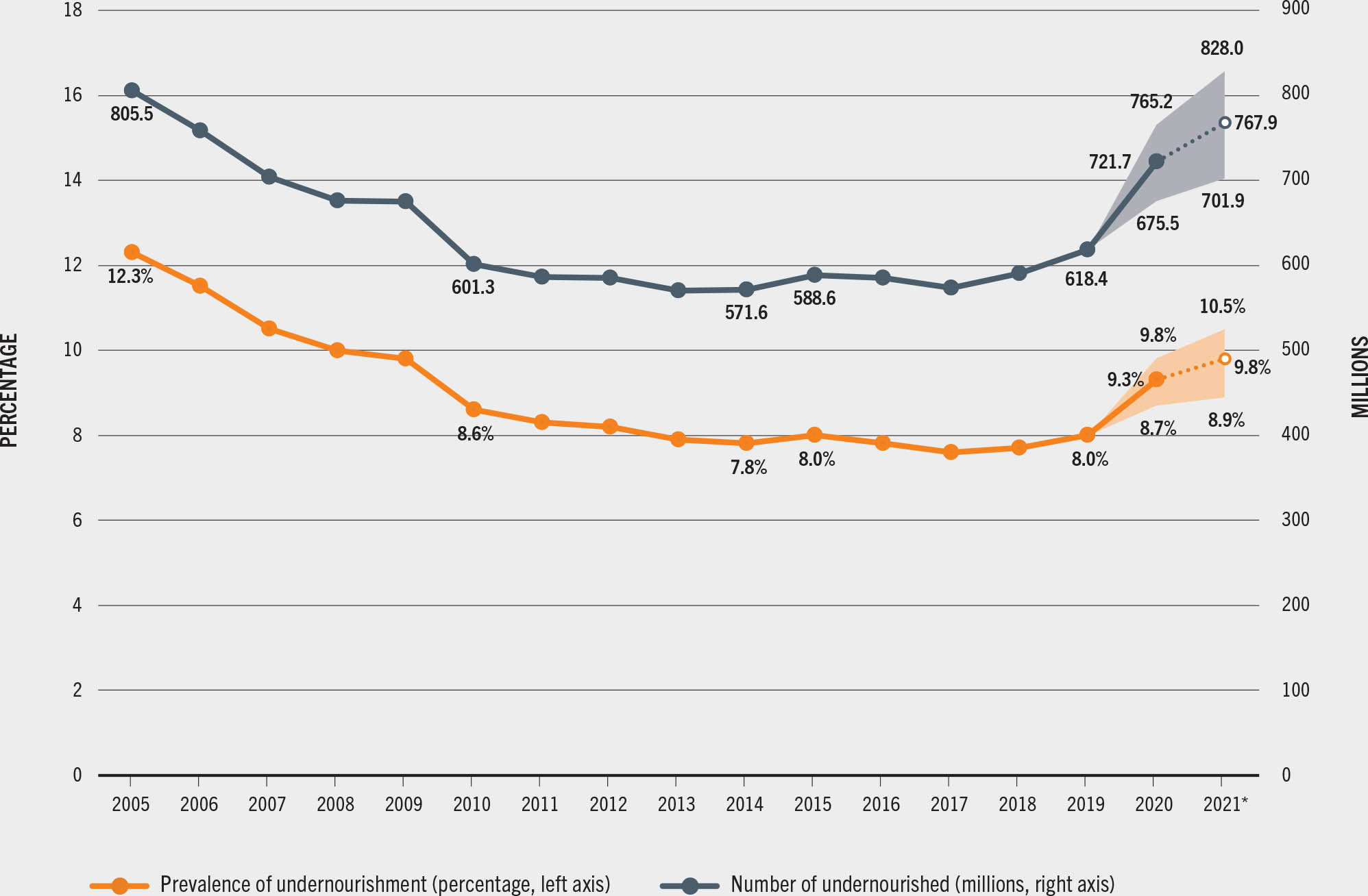
SOURCE: FAO.
The numbers show persistent regional disparities, with Africa bearing the heaviest burden. One in five people in Africa (20.2 percent of the population) was facing hunger in 2021, compared to 9.1 percent in Asia, 8.6 percent in Latin America and the Caribbean, 5.8 percent in Oceania, and less than 2.5 percent in Northern America and Europe. Africa is also the region where the proportion of the population affected by hunger has increased the most. Since the launch of the Sustainable Development Agenda in 2015, the PoU for Africa has risen 4.4 percentage points, compared to 2.8 and 1.1 percentage points in Latin America and the Caribbean and Asia, respectively (Table 1).
TABLE 1PREVALENCE OF UNDERNOURISHMENT (PoU), 2005–2021
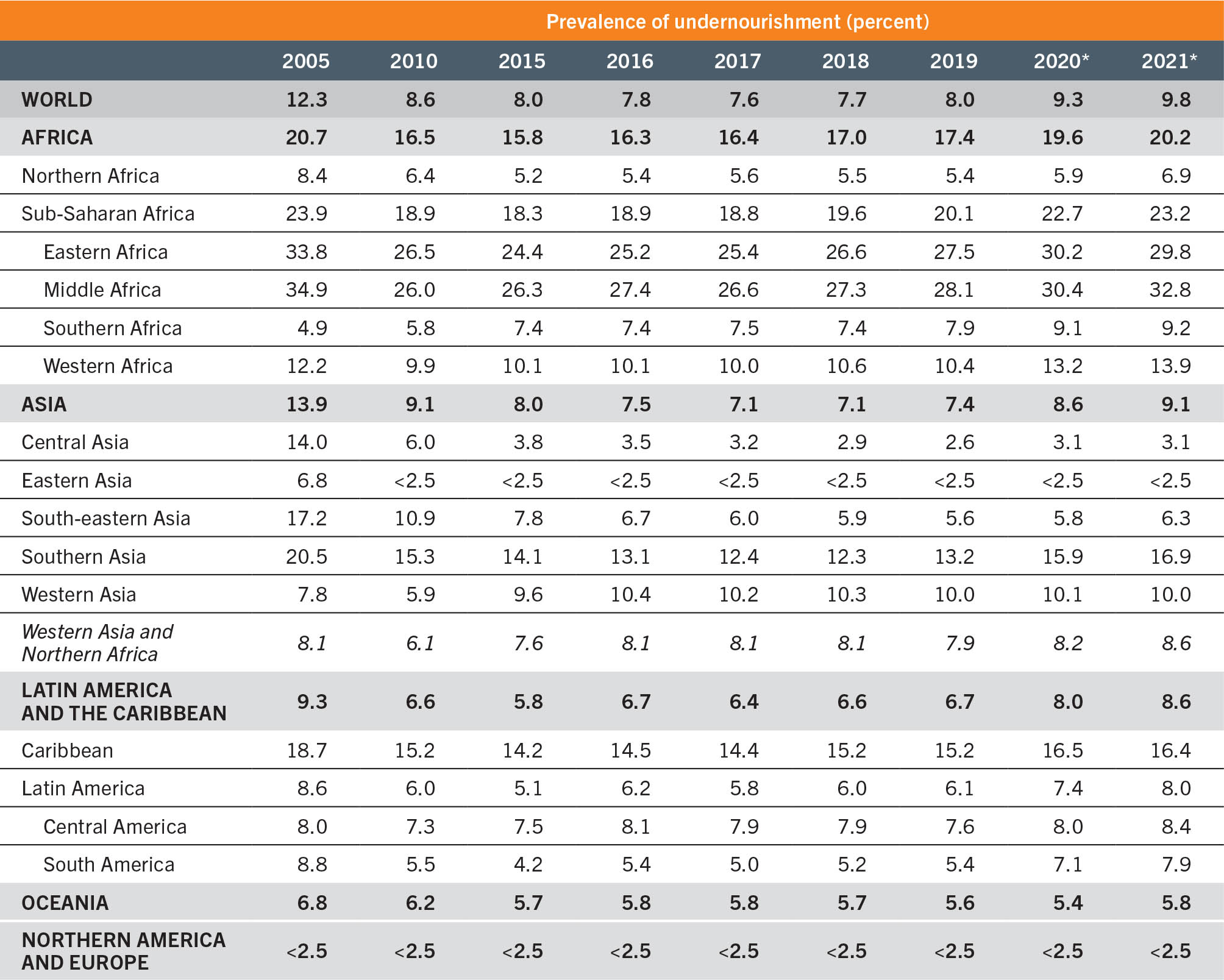
SOURCE: FAO.
Looking more closely at the past two years, in Africa, a jump of more than 2 percentage points occurred from 2019 to 2020, under the shadow of the COVID-19 pandemic, followed by a 0.6 percentage point increase from 2020 to 2021. Similar trends were seen in Latin America and the Caribbean and in Asia, which experienced increases of more than 1 percentage point from 2019 to 2020 followed by a further 0.5 percentage-point increase in 2021 (Table 1).
While the regional prevalence estimates reveal the magnitude of the burden of hunger in each region, translating them into numbers of people gives a sense of where most of the people facing hunger in the world live (Table 2 and Figure 3). Of the total number of undernourished people in 2021 (768 million), more than half (425 million) live in Asia and more than one-third (278 million) in Africa, while Latin America and the Caribbean accounts for close to 8 percent (57 million). In Africa, 35 million more people were affected by hunger in 2020 compared with 2019, prior to the outbreak of the COVID-19 pandemic, with an additional 15 million in 2021, for a total of 50 million more people in two years. Similarly, 9 million more people were hungry in Latin America and the Caribbean in 2020 than in 2019, and an additional 4 million were thrust into hunger between 2020 and 2021. In Asia, the increases were of 58 million in 2020 and 26 million in 2021.
TABLE 2NUMBER OF UNDERNOURISHED PEOPLE (NoU), 2005–2021
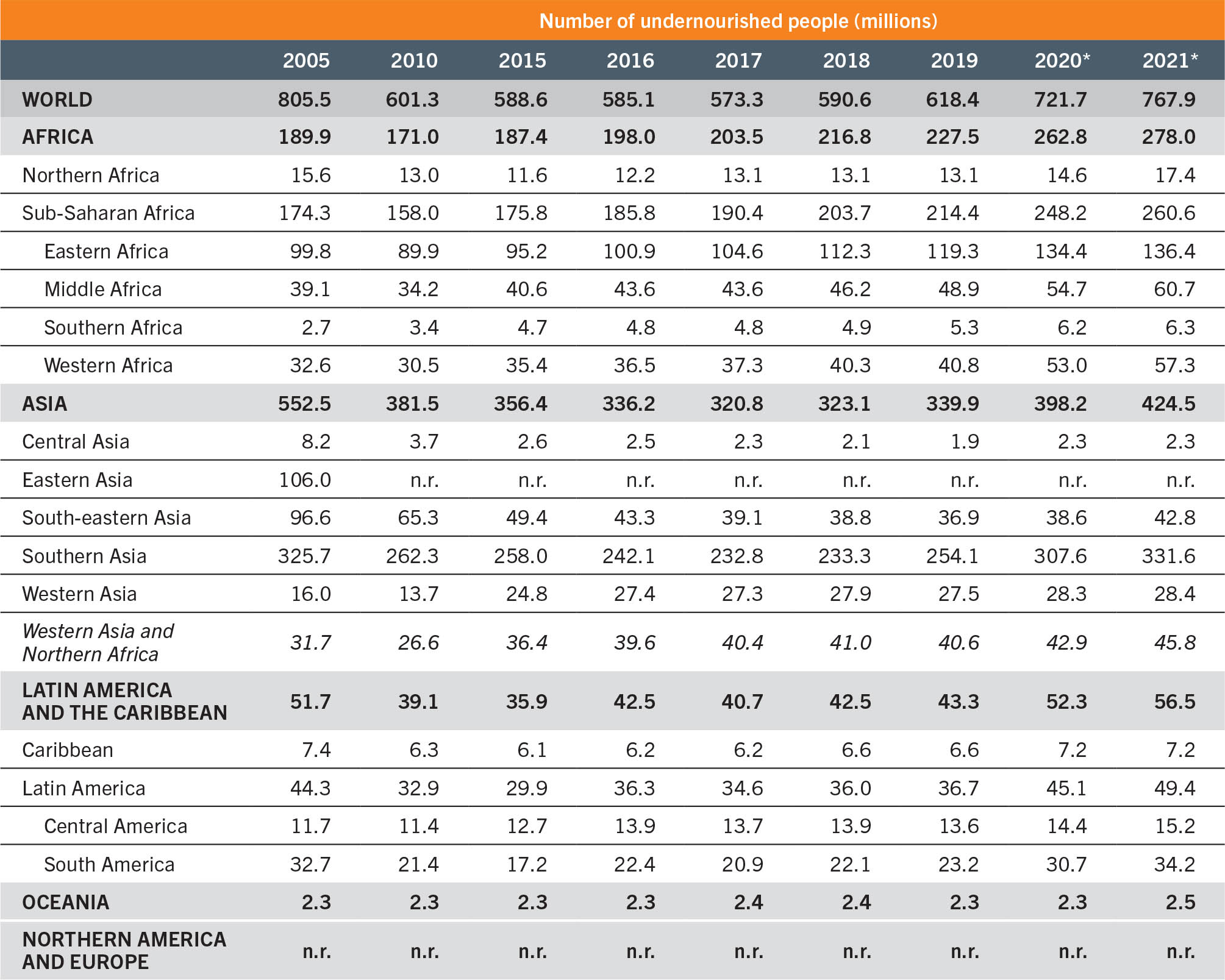
SOURCE: FAO.
FIGURE 3 More than half (425 million) of the people in the world affected by hunger in 2021 were in Asia and more than one-third (278 million) in Africa
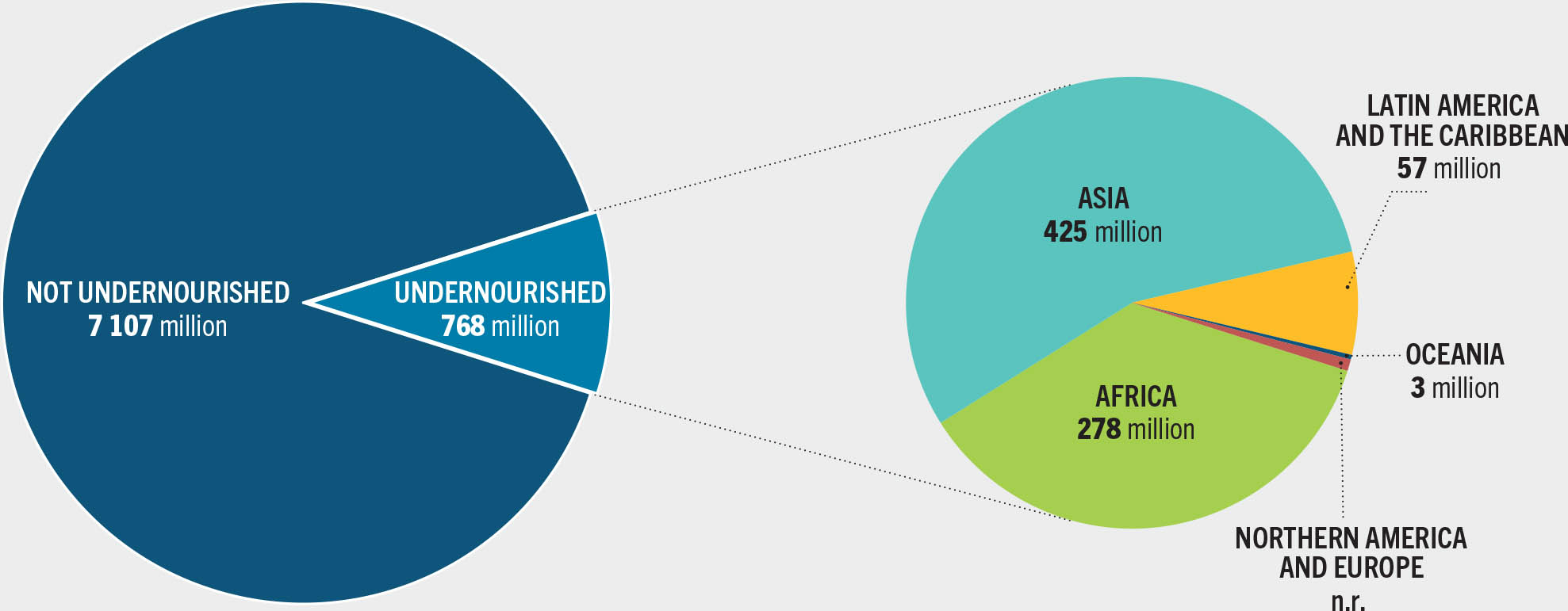
SOURCE: FAO.
Looking more closely at differences at the subregional level (Table 1 and Table 2, and Figure 4), the proportion of the population affected by hunger in Northern Africa in 2021 (6.9 percent) is much smaller than in almost all subregions of sub-Saharan Africa and somewhat smaller compared to Southern Africa (9.2 percent). In the other subregions of Africa, the PoU in 2021 ranges from 13.9 percent in Western Africa to 32.8 percent in Middle Africa. Following increases in hunger in all subregions in 2020, most have shown a further increase in 2021. The PoU increased by more than 2 percentage points in Middle Africa for two years in a row. In Eastern Africa, the subregion with the largest NoU (more than 136 million), the PoU jumped 2.7 percentage points in 2020 and then remained relatively stable in 2021. There were smaller increases from 2020 to 2021 compared to the previous year in both Southern and Western Africa, which reflect the lingering effects of the COVID-19 pandemic.
FIGURE 4 AFTER INCREASING FROM 2019 TO 2020 IN MOST OF AFRICA, ASIA AND LATIN AMERICA AND THE CARIBBEAN, THE PoU CONTINUED TO RISE IN 2021 IN MOST SUBREGIONS, BUT AT A SLOWER PACE
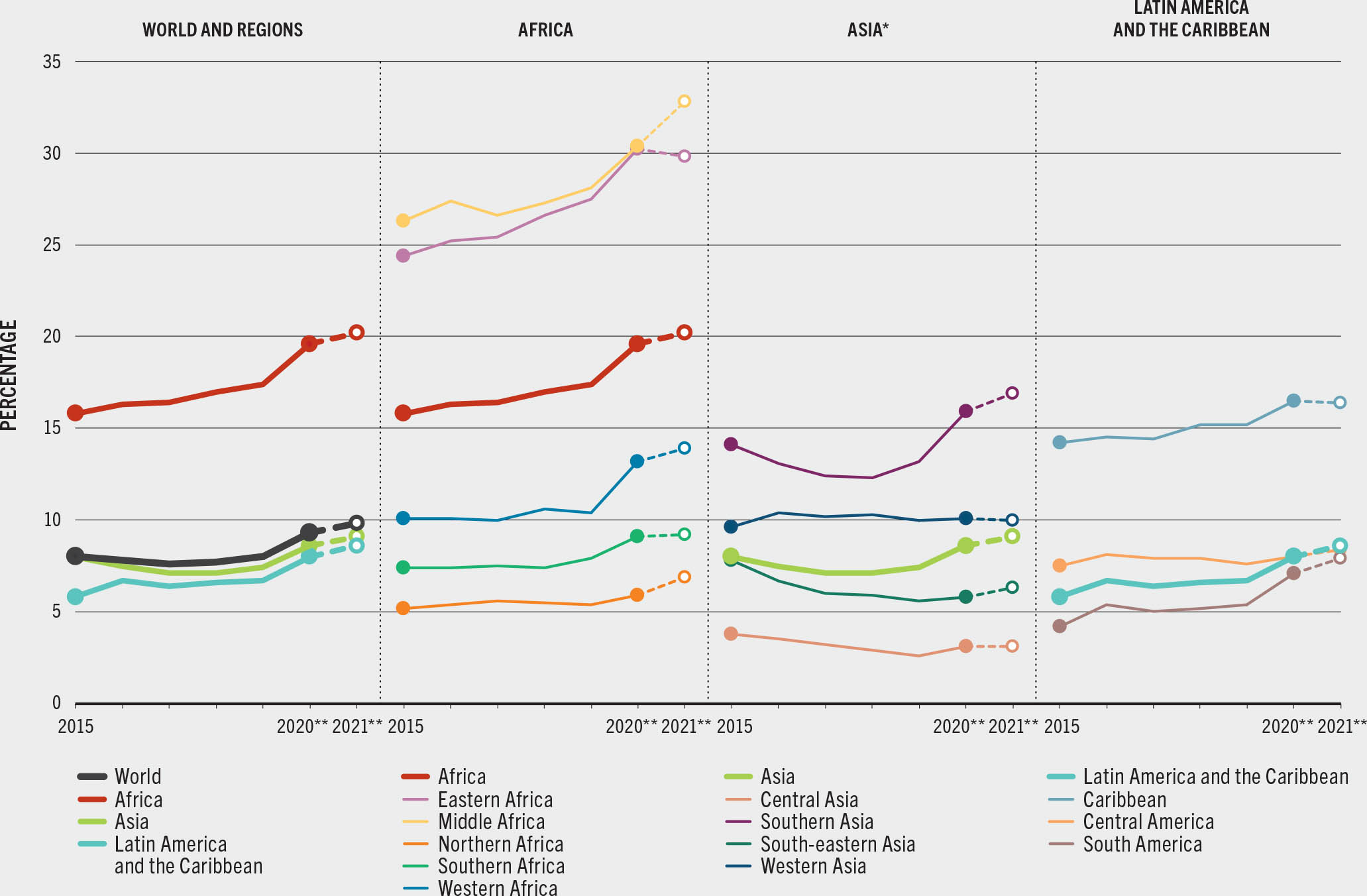
SOURCE: FAO.
The differences between subregions in Asia are also noteworthy. The proportion of the population facing hunger in Central Asia and Eastern Asia was low in 2021 (about 3 percent and <2.5 percent, respectively) compared to Western Asia (10 percent) and, especially, to Southern Asia (16.9 percent), which is the subregion in the world with the highest NoU – more than 330 million. The general trend across most subregions was of a steady decrease in hunger between 2015 and 2019 with upturns beginning in 2020. Southern Asia saw a small upturn already in 2019 followed by a jump from 13.2 to 15.9 percent between 2019 and 2020 in the context of the pandemic, and a further increase to 16.9 in 2021. Relatively smaller increases were observed for two consecutive years in South-eastern Asia, where an estimated 6.3 percent of the population was facing hunger in 2021. Levels have remained around 10 percent in Western Asia and 3 percent in Central Asia for the past five years and below 2.5 percent in Eastern Asia for more than a decade.
In Latin America and the Caribbean, the Caribbean presents the highest proportion of the population affected by hunger (slightly over 16 percent), compared with about 8 percent in Central America and in South America. However, in the Caribbean, after a general upward trend in hunger since 2015, and a notable increase from 2019 to 2020, the PoU remained unchanged from 2020 to 2021, albeit still above pre-pandemic levels. In contrast, hunger rose further in South America and Central America from 2020 to 2021. The PoU has nearly doubled in South America since 2015, where increases of 1.7 and 0.8 percentage points were registered in 2020 and 2021, respectively. In Central America, the PoU has increased little since 2015, although it rose 0.4 percentage point per year for the last two years.
Inequalities persist despite the economic rebound
The further increase in global hunger in 2021 following the sharp upturn in 2020 is consistent with existing evidence of the persisting economic hardships induced by the COVID-19 crisis that have widened inequalities in access to food.
In 2021, the recovery in terms of GDP growth has been highly uneven across countries, mainly in detriment to LICs and lower-middle-income countries (LMICs). While high-income countries (HICs) are recovering at a solid pace with a good prospect of regaining their pre-pandemic real per capita income levels in 2022, LICs and LMICs are experiencing a much slower pace of economic growth, and most are not expected to return to their pre-pandemic levels by 2022.6
Disadvantaged groups of the population, such as women, youth, low-skilled workers and workers in the informal sector, were disproportionately impacted by the economic crisis that was triggered by the COVID-19 pandemic and by the measures implemented to contain it. These groups were more likely to report job and income losses.6 Gender differences in work stoppage, for instance, were prominent; data from high-frequency phone surveys in 40 countries collected by the World Bank and National Statistics Offices show that 36 percent of women reported stopping work during the pandemic compared to 28 percent of men.7
Projections by the World Bank showed that while the top 20 percent of the global income distribution had recovered in 2021 about half of the income lost during 2020, the bottom 40 percent of the income distribution had not yet started to recover their income losses (see Figure 5).8,9,10 At the same time, data from the aforementioned high-frequency surveys indicate that the employment and earning losses of disadvantaged groups, including women, had only partially recovered.7 This shows that the crisis has had deeper and more protracted effects on disadvantaged groups, which has worsened the existing inequalities within countries.
FIGURE 5 Comparison of percent of income loss by global income quintile due to the COVID-19 pandemic in 2020 and 2021 shows large disparities in income recovery
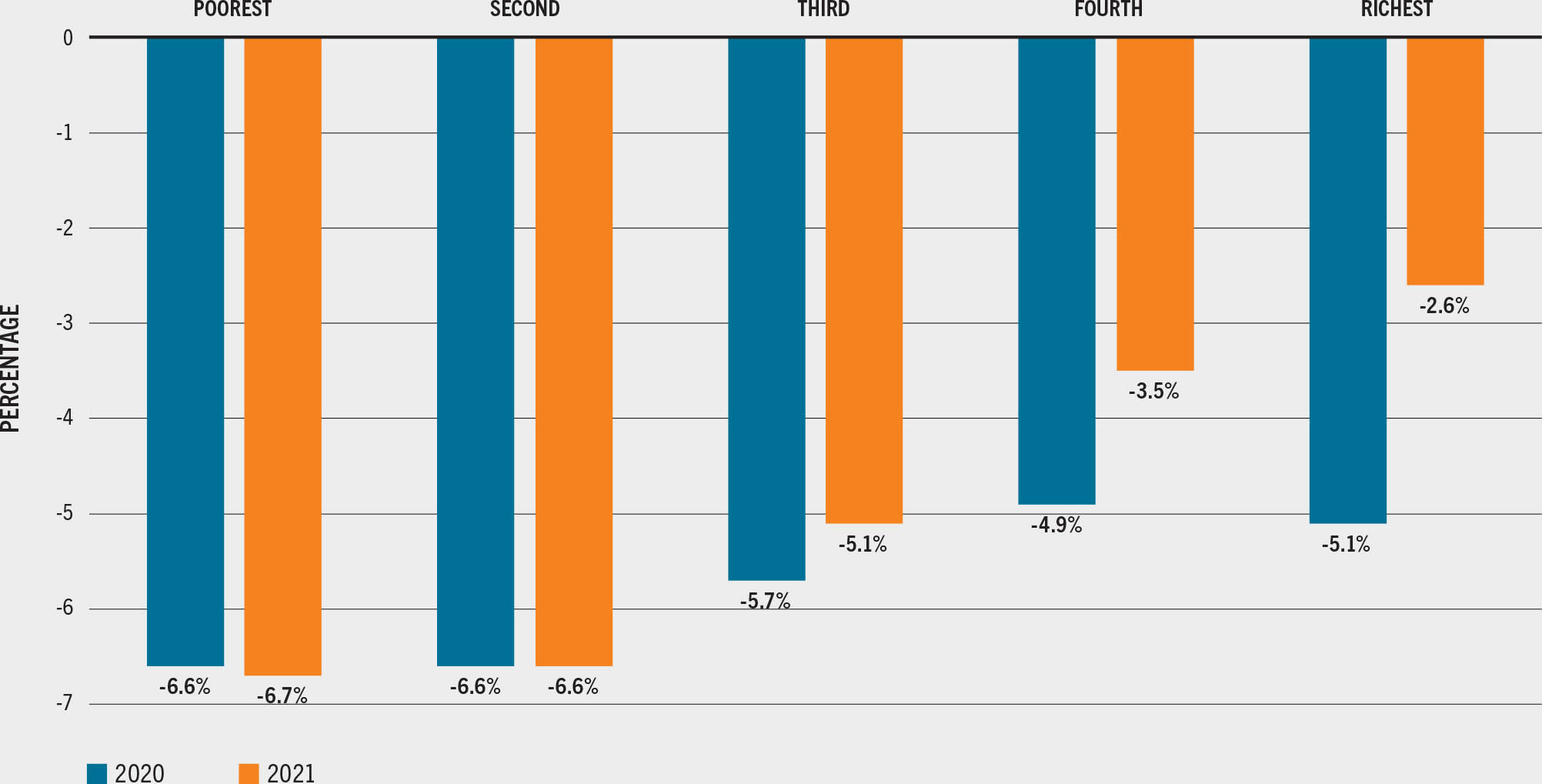
SOURCE: Sánchez-Páramo, C., Hill, R., Mahler, D.G., Narayan, A. & Yonzan, N. 2021. COVID-19 leaves a legacy of rising poverty and widening inequality. In: World Bank Blogs. Washington, DC., World Bank. Cited 5 May 2022. https://blogs.worldbank.org/developmenttalk/covid-19-leaves-legacy-rising-poverty-and-widening-inequality
As a result, not only did global extreme poverty increase,11 but so did global income inequality for the first time in 20 years.9 However, the increase in poverty would likely have been even larger in the absence of the observed surge in social protection interventions. Between March 2020 and May 2021, as many as 222 countries or territories had planned or implemented social protection measures in response to the COVID-19 pandemic.12 Nevertheless, the coverage, inclusiveness and adequacy of these measures varied. Over 40 percent of the social protection measures identified in the review consisted of one-time payments, and nearly three-fourths lasted three months or less – far less than the reverberations of the pandemic.13,14
These disparities in the impact of the pandemic and the recovery, together with the limited coverage and duration of the social protection measures, led to widening inequalities. As noted in previous editions of this report, inequalities are among the root causes of food insecurity; thus, it is likely that growing inequalities in 2020 weakened the capacity of the economic recovery to translate into increased food security, as is reflected in the growing number of people facing difficulties in accessing food.
Towards ending hunger (SDG Target 2.1): projections to 2030
The prospects for achieving Zero Hunger by 2030 (SDG Target 2.1) are disheartening. Last year’s report already presented discouraging projections of how many people may be affected by hunger in 2030 based on extrapolation of recent trends in the three fundamental variables used to compute the PoU for each country: the total supply of food, the population size and composition (which determine the total dietary energy requirements) and the degree of inequality in food access within the population.15
Using the methods introduced last year (see Annex 2), the projections of the NoU in 2025 and 2030 have been updated to reflect the current assessment of the situation in 2021 (see Table 1). Two scenarios are presented: a reference scenario (hereby referred to as the COVID-19 scenario) aimed at capturing the macroeconomic impact of the COVID-19 pandemic as reflected in the April 2022 update of the International Monetary Fund’s (IMF) World Economic Outlook, and a no-COVID-19 scenario calibrated to reflect the situation of the world economy in 2018/19 before the COVID-19 pandemic, and long-term prospects as captured in the October 2019 edition of World Economic Outlook (Figure 6).
FIGURE 6The COVID-19 scenario projects a decrease in global hunger to around 670 million in 2030, far from the zero hunger target. This is 78 million more undernourished people in 2030 than in a scenario in which the pandemic had not occurred

SOURCE: FAO.
The new projections depict a somewhat worse situation compared to last year’s. The conjecture that hunger would begin to decline as early as 2021, driven by the expected economic recovery, did not come to pass. As discussed above, the lasting impacts of the COVID-19 pandemic, and consequent increase in inequalities, prevented this expectation from materializing.
It is projected that nearly 670 million people will still be undernourished in 2030 – 8 percent of the world population, which is the same proportion as in 2015 when the 2030 Agenda was launched. This is 78 million more undernourished people in 2030 compared to a scenario in which the pandemic had not occurred. The projected gradual reduction in global hunger by 2030 is largely due to the significant improvements foreseen for Asia, where the NoU is projected to fall from the current 425 million to around 295 million (equivalent to about 6 percent of the population), and to a simultaneous worsening in Africa, where the NoU is projected to grow from almost 280 to more than 310 million (corresponding to slightly above 18 percent of the population). For Latin America and the Caribbean, the number of people affected by undernourishment is projected to remain stable until 2030 at around 56 million (which correspond to about 8 percent of the population).
At the time of writing this report, another crisis looms that is likely to impact the trajectory of food security globally: the war in Ukraine. As explained in more detail in Box 3, the Russian Federation and Ukraine are prominent players in the global trade of food and agricultural products, in particular of wheat, maize, sunflower, sunflower oils and fertilizers in markets characterized by exportable supplies concentrated in a handful of countries. This concentration makes these markets, in particular, vulnerable to shocks such as the one that the current war represents. Several risks emanate from the conflict that will directly and indirectly impact global supply. Among them, the risk of disruptions in trade flows, and the resulting risk of soaring prices, are among the first to consider. In addition, the potential risk of reduced production levels of the next harvest and logistical risks like those posed by damage of transport, storage and processing infrastructure are also to be considered. Taken together, they cast a looming shadow over the prospect of food insecurity in the short and medium term, especially in impoverished countries, and constitute a challenge to the achievement of the SDG 2 target of Zero Hunger.
BOX 3The war in Ukraine: potential risks for international agricultural markets and global food security16,17
The Russian Federation and Ukraine are among the most important producers of agricultural commodities in the world. Before the crisis, the two countries together supplied 30 percent and 20 percent of global wheat and maize exports, respectively. They also accounted for close to 80 percent of global exports of sunflower seed products. Furthermore, the Russian Federation is a world leading exporter of nitrogen, potassium and phosphorous fertilizers, whose prices have been increasing since late 2020 because of rising energy prices as well as rising transportation costs in the wake of the COVID-19 pandemic. The disruptions to agricultural exports caused by the war in Ukraine have exposed global food and fertilizer markets to heightened risks of tighter availabilities, unmet import demand and higher international prices. Many countries that are highly dependent on imported foodstuffs and fertilizers, including numerous that fall into the groups of least developed countries (LDCs) and low-income food-deficit countries (LIFDCs), rely on Ukrainian and Russian food supplies to meet their consumption needs. Many of these countries, already prior to the conflict, had been grappling with the negative effects of high international food and fertilizer prices.
In Ukraine, the escalation of the conflict raises concerns over whether crops will be harvested and products exported. There is also uncertainty surrounding Russian export prospects, because of sales difficulties that may arise as a result of financial and shipping constraints. Such export shortfalls are likely to elevate already high world food commodity prices even further. FAO simulations gauging the potential impacts of a sudden and steep reduction in grain and sunflower seed exports by the two countries indicate that these shortfalls may be only partially compensated by the release of stocks during the 2022/23 marketing season. Due to this high degree of uncertainty, simulations are presented using two scenarios. In a moderate scenario, which assumes an export shortfall in grains and oilseeds totalling 24 million tonnes in 2022/23 and a crude oil price of USD 100/barrel, world wheat price would increase by 8.7 percent. In the case of a more severe shock to global grain and oilseed markets (58 million tonnes total export shortfall), the increase in the international wheat price is estimated at 21.5 percent, compared to the already high baseline level. Prices of the other cereals and oilseeds would also increase, but to a lesser extent.
Such export shortfalls may also result from damage to inland transport infrastructure and seaports, as well as to storage and processing infrastructure in Ukraine. The impact is further compounded by limited alternatives, such as moving goods by rail instead of ship or switching to smaller processing facilities from modern oilseed crushing plants, in the case of damage to key facilities. Further increasing costs of maritime transportation would compound the effects on the final costs of internationally sourced food products paid by importers.
A conflict affecting these important global agricultural commodity market players, at a time of already high and increasingly volatile international food and input prices, raises significant concerns over the potential negative impact on global food security. FAO simulations suggest that under the moderate shock scenario, the global NoU in 2022 would increase by 7.6 million people, while this rise would amount to 13.1 million people above baseline estimates under the more severe shock setting (Figure A).
Figure A Estimated impact of the war in Ukraine on the global number of undernourished people in 2022

SOURCE: FAO calculations.
A third scenario simulating the severe export shortfall from Ukraine and the Russian Federation in 2022 and 2023, and assuming no global production response, suggests an increase in the NoU by close to 19 million people in 2023.
From a regional perspective, vulnerable populations in sub-Saharan Africa and the Near East and North Africa are the most at risk of increased undernourishment due to the conflict (Figure B). The low-income level, associated with the high shares of food expenditure in sub-Saharan Africa, and the particularly high dependency of the Near East and North Africa diets on imported wheat, especially from Ukraine and the Russian Federation, make poor consumers extremely vulnerable to wheat, maize and vegetable oil price shocks.
Figure B Estimated Increase in the number of undernourished people IN 2022 by region
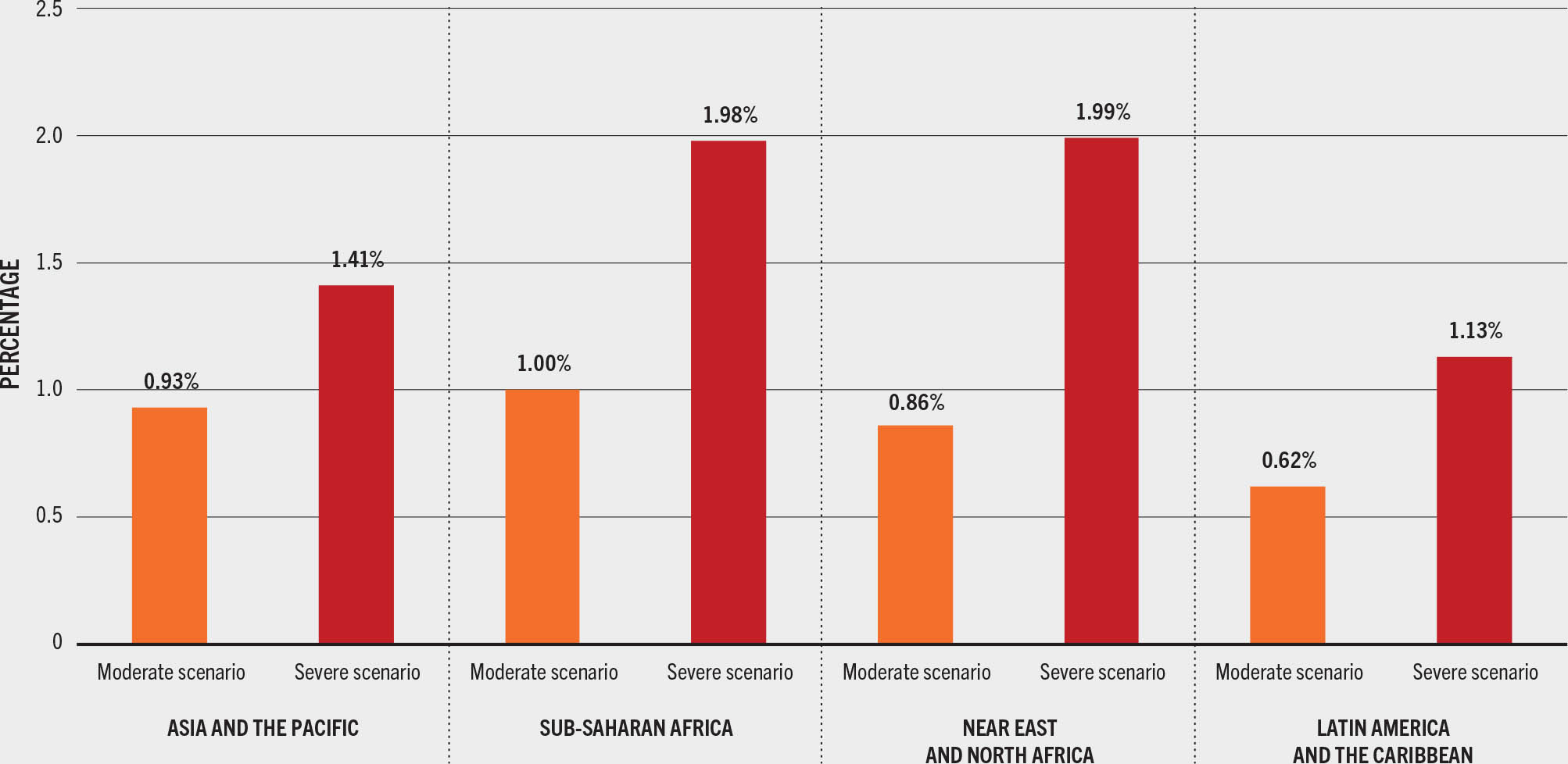
SOURCE: FAO calculations.
Besides the direct impact on global food supplies, the conflict poses a number of additional risks that will also impact agricultural production and trade. As a highly energy-intensive industry, especially in industrialized regions, agriculture will inevitably be affected by the sharp increase in energy prices. With the prices of fertilizers and other energy-intensive products rising as a consequence of the conflict, overall input prices are expected to experience a considerable hike. The higher prices of these inputs will first translate into higher production costs and eventually into higher food prices. They could also lead to lower input use levels, reducing global crop production, thus giving further upside risk to the state of global food security in the coming years.
The conflict and the subsequent economic sanctions against the Russian Federation are also likely to impact exchange rates, debt levels and overall economic growth prospects. In April 2022, the IMF released its World Economic Outlook, with global growth projected to slow down from an estimated 6.1 percent in 2021 to 3.6 percent in 2022 and 2023 because of the war. This represents 0.8 and 0.2 percentage point lower for 2022 and 2023, respectively, than projected in January 2022. The IMF expects a severe double-digit drop in GDP for Ukraine and a large contraction in the Russian Federation, which can have worldwide spillover effects through commodity markets, trade, remittance flows and financial channels. Reduced GDP growth in several parts of the world will affect global demand for agrifood products. Furthermore, a lasting appreciation of the USD, especially in the context of rising interest rates in the United States of America, may have significant economic consequences for developing regions and increase their debt burdens. While the full impact of the ongoing war on the global economy remains uncertain at this stage and will depend on several factors, the poor and most vulnerable countries and populations are expected to be the hardest hit by slower economic growth and high inflation, with consequent increases in hunger and malnutrition (see Box 5), as well as in the cost of a healthy diet. All of this comes at a time when the world is still attempting to recover from the recession triggered by the COVID-19 pandemic.
The unfolding crisis adds additional uncertainty to the projections of global hunger levels in 2030, which may well affect the projected scenarios in Figure 6. While it is still premature to try to quantify the impact of the conflict, given the many different pathways through which it could impact global food insecurity, Box 3 presents simulations of the potential impact of the war in 2022 that take into account two of the risks induced by the conflict: the trade risk (reflected in interrupted wheat and maize exports from Ukraine) and the price risk (reflected in the rise in prices of commodities and energy).
SDG Indicator 2.1.2 Prevalence of moderate or severe food insecurity in the population, based on the FIES
Ending hunger is an urgent imperative for the preservation of life and human dignity. SDG Target 2.1 challenges the world to go further by ensuring access for all to safe, nutritious and sufficient food all year round. SDG Indicator 2.1.2 – the prevalence of moderate or severe food insecurity in the population, based on the FIES – is used to monitor progress towards the ambitious goal of ensuring access to adequate food for all.
The FIES also enables the estimation of the prevalence of food insecurity at severe levels only, which provides a supplementary lens for monitoring hunger. Although obtained using very different data and methods (see Annex 1B), the prevalence of severe food insecurity is expected to correlate with the PoU across populations. This is because people experiencing severe food insecurity are unlikely to be able to acquire enough food to continuously fulfil their dietary energy requirements, which is the concept of chronic undernourishment measured by the PoU.3,18
FIES data are increasingly available from official national sources as a growing number of countries have adopted the FIES as a standard food security assessment tool. FIES or equivalent experience-based food security data collected by national institutions were used to inform the estimates in this year’s edition of this report for more than 59 countries, covering more than a quarter of the world population. For the remaining countries, estimates are based on FIES data collected by FAO, mainly through the GWP (see Annex 1B). Additionally, this year’s report is also informed by FIES data collected by FAO in 2021 for 20 LDCs, land locked developing countries (LLDCs) and Small Island Developing States (SIDS), all for which food security data are scarce.19 In this sense, data collected for the very first time in island nations of the Caribbean, Africa and Asia,c for example, help to broaden our understanding of the status of food insecurity in vulnerable countries.
The prevalence of moderate or severe food insecurity at the global level has been increasing since FAO first started collecting FIES data in 2014 (Figure 7 and Table 3). In 2020, the year the COVID-19 pandemic spread across the globe, it rose nearly as much as in the previous five years combined. New estimates for 2021 suggest that the prevalence of moderate or severe food insecurity has remained relatively unchanged compared with 2020, whereas severe food insecurity has increased, providing further evidence of a deteriorating situation mainly for those already facing serious hardships.
FIGURE 7Moderate or severe food insecurity remained stable at the global level despite increases in every region except Asia, whereas severe food insecurity increased globally and in every region
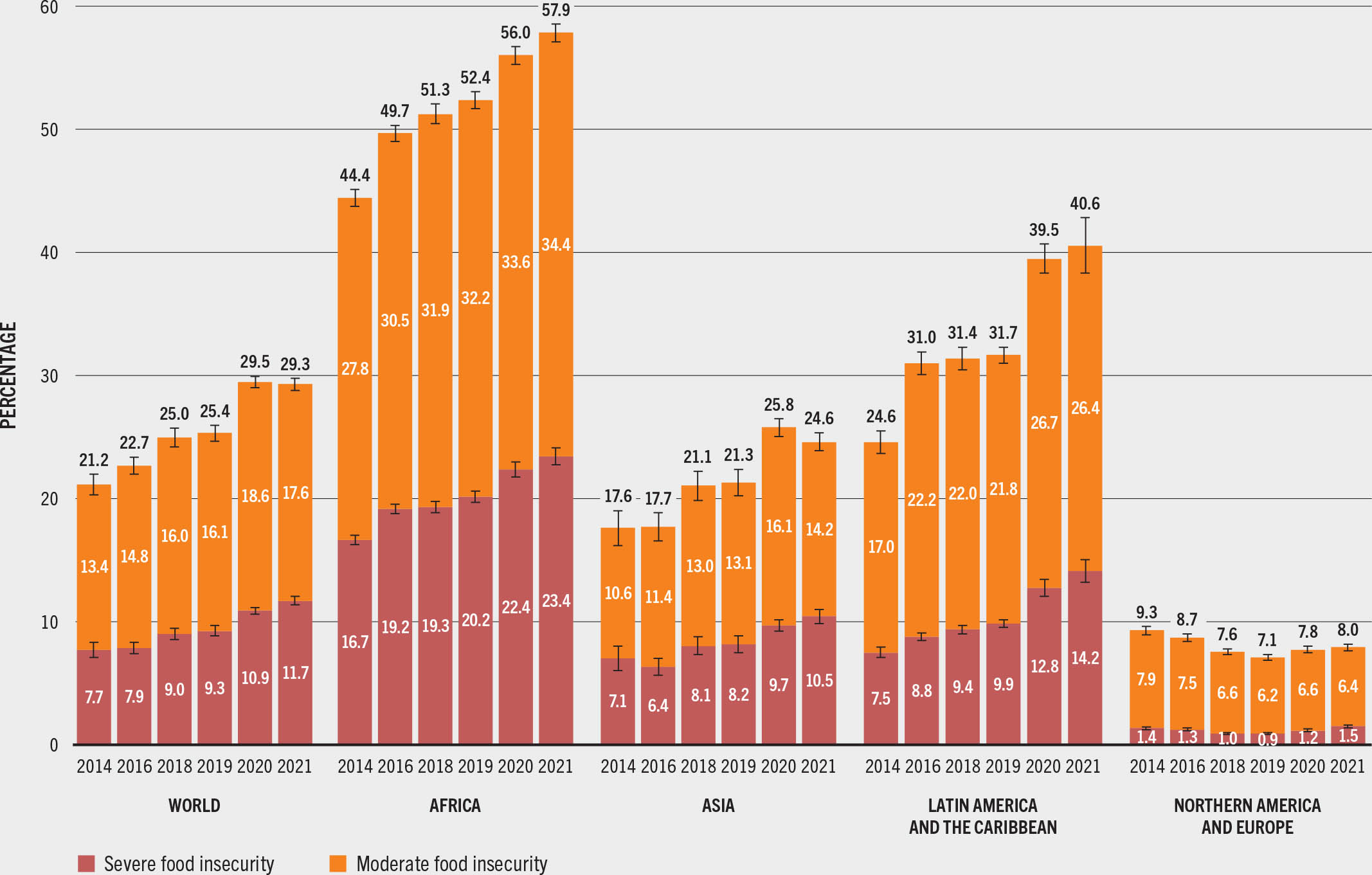
SOURCE: FAO.
TABLE 3Prevalence of food insecurity at severe level only, and at moderate or severe level, based on the Food Insecurity Experience Scale, 2014–2021
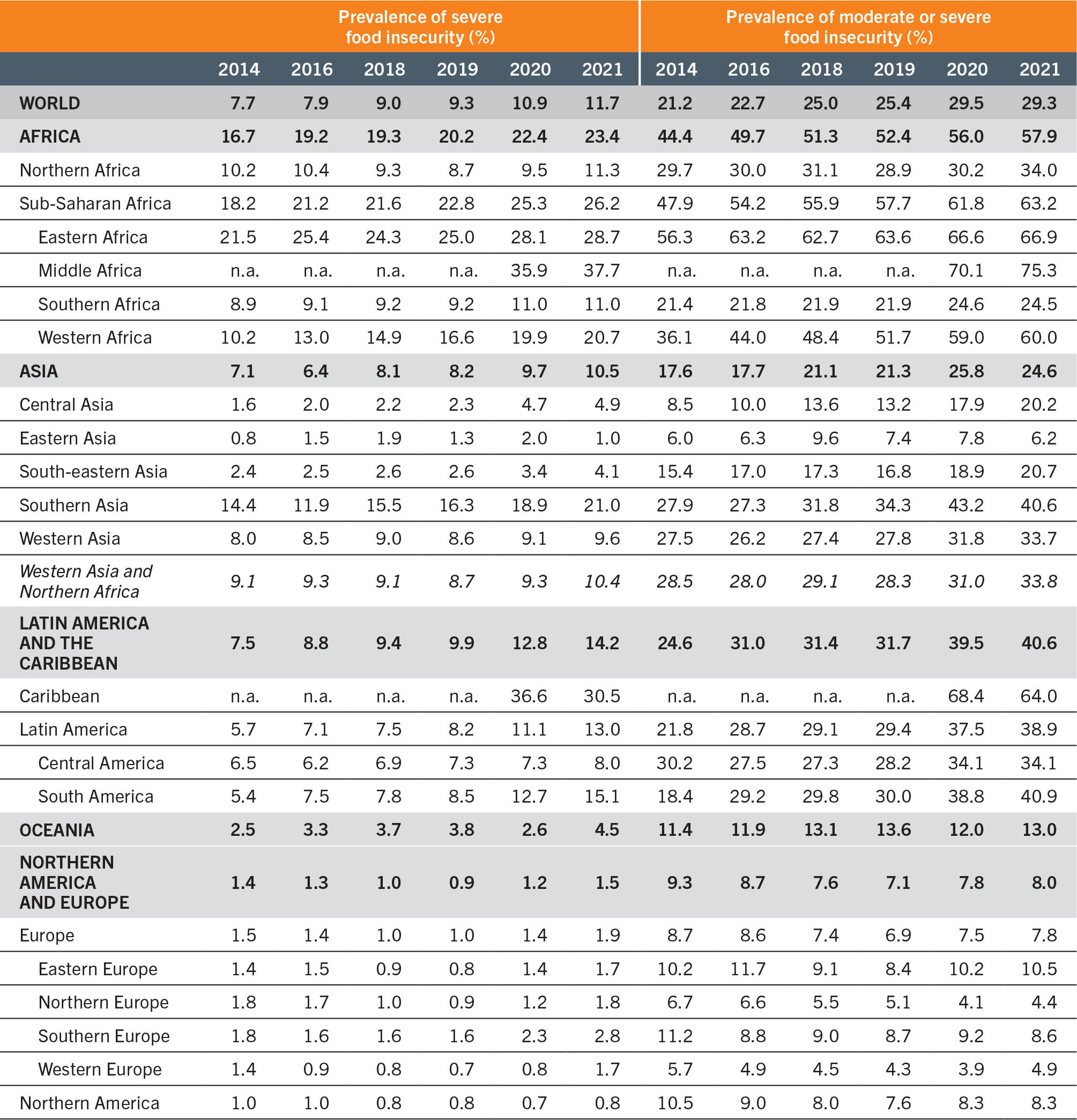
SOURCE: FAO.
In 2021, an estimated 29.3 percent of the global population – 2.3 billion people – were moderately or severely food insecure, meaning they did not have access to adequate food (Table 3 and Table 4). Although the number remained relatively stable between 2020 and 2021, more than 350 million more people were affected by moderate or severe food insecurity in 2021 compared to 2019, the year before the COVID-19 pandemic unfolded.
TABLE 4Number of people experiencing food insecurity at severe level only, and at moderate or severe level, based on the Food Insecurity Experience Scale, 2014–2021
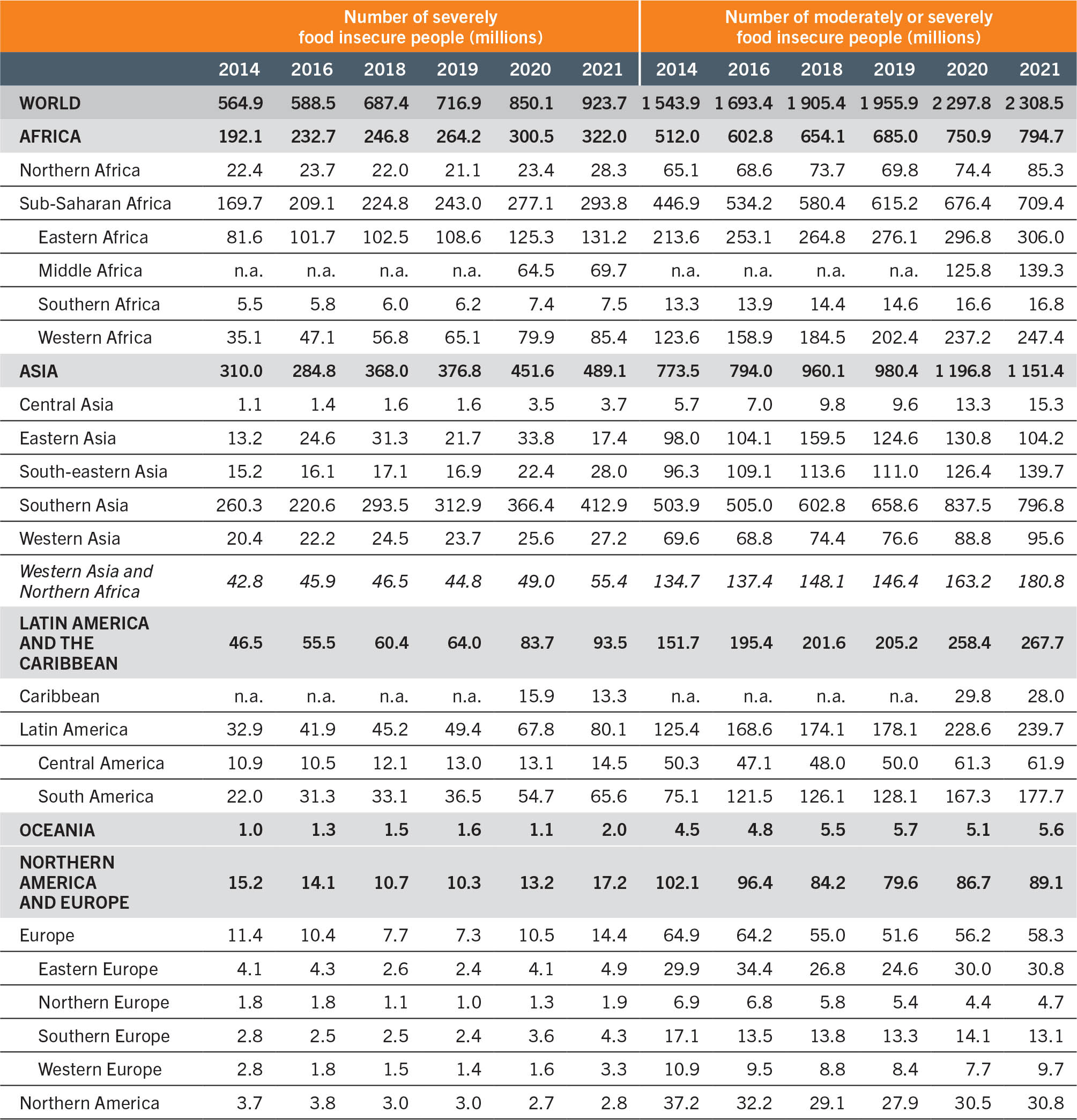
SOURCE: FAO.
Of those people affected by moderate or severe food insecurity, close to 40 percent of them were facing food insecurity at severe levels, indicating they had run out of food and, at worst, gone a day without eating. The global prevalence of severe food insecurity rose from 9.3 to 10.9 percent between 2019 and 2020, and to 11.7 percent in 2021. An estimated 923.7 million people faced severe food insecurity in 2021 – 73.6 million more than in 2020 and 207 million more people compared to 2019.
The estimated numbers of severely food insecure people presented in Table 4 and of undernourished people presented in Table 2 show similar trends. However, the number of severely food insecure people in the world in 2021, as well as the increase in the number of severely food insecure people from 2020 to 2021, are somewhat greater compared to the estimates of undernourished people presented in the preceding section, based on the middle range estimate in Table 2. This is because the indicators are based on very different methodologies and sources of data. As explained, the FIES data were collected directly from respondents in surveys, providing timely and robust estimates, while the 2021 PoU estimates are nowcasts based on data on food availability and access to food at the country level.
While levels of moderate or severe food insecurity remained stable at the global level, differing trends were seen at the regional level. The largest increase in moderate or severe food insecurity between 2020 and 2021 was seen in Africa, which also has the highest prevalence at both levels of severity. Moderate or severe food insecurity increased 1.9 percentage points in one year to 57.9 percent, and severe food insecurity increased 1 percentage point, affecting nearly one in four people in the region in 2021. An estimated 322 million Africans were facing severe food insecurity – 21.5 million more than in 2020 and 58 million more than in 2019 prior to the COVID-19 pandemic. Globally, more than one-third of the total number of people facing severe food insecurity in 2021 live in Africa.
Differences at the subregional level in Africa are noteworthy. The prevalence of food insecurity in Northern Africa is roughly half that of sub-Saharan Africa; however, the food security situation appeared to worsen more in Northern Africa from 2020 to 2021. Within sub-Saharan Africa, Middle Africa is the subregion facing the highest levels of food insecurity and is also where the largest increases occurred from 2020 to 2021.
Food security also continued to worsen in Latin America and the Caribbean, although the deterioration has slowed following a relatively sharp rise in food insecurity in 2020. In 2021, 40.6 percent of the population was facing moderate or severe food insecurity – an increase of 1.1 percentage points since 2020, which is within the margins of error. Severe food insecurity rose 1.4 percentage points to reach 14.2 percent – an increase of nearly 10 million more people in one year and almost 30 million more when compared with 2019. The prevalence of severe food insecurity in the region has nearly doubled since FIES data were first collected in 2014.
The rise in food insecurity in Latin America and the Caribbean is driven largely by an increase in South America. The prevalence of moderate or severe food insecurity in South America increased sharply from 2019 to 2020 (nearly 9 percentage points) and then rose at a slower pace from 2020 to 2021 to about 41 percent. However, there was a more notable rise in severe food insecurity in South America from 2020 to 2021, bringing the level to over 15 percent. In Central America, food insecurity levels have remained relatively stable since 2020 following a sharp increase from 2019 to 2020. The estimated prevalence of moderate or severe food insecurity in 2020 and 2021 for this subregion was slightly over 34 percent. The Caribbean is the subregion with the highest prevalence of food insecurity (64 percent moderate or severe food insecurity and 30.5 percent severe food insecurity), but an encouraging downward trend was observed from 2020 to 2021.d
The food insecurity situation was comparatively better in Asia, where the combined prevalence of moderate and severe food insecurity decreased slightly from 25.8 percent in 2020 to 24.6 percent in 2021. Nevertheless, given the size of its population, Asia accounts for half the people facing moderate or severe food insecurity in the world – more than 1.15 billion. Furthermore, the prevalence of severe food insecurity actually increased to 10.5 percent. An estimated 37.5 million more people faced severe food insecurity in Asia in 2021 compared to 2020 – a larger increase in terms of absolute numbers than in Africa. When compared with 2019, 112.3 million more people were facing food insecurity at severe levels in 2021.
The subregion of Asia with the highest levels of food insecurity is Southern Asia, where 40.6 percent of the population was moderately or severely food insecure in 2021. This represents an increase of about 6 percentage points since 2019 and more than 13 percentage points in five years, despite a 2.6 point decrease from 2020 to 2021. Of the people affected by moderate or severe food insecurity, half were facing severe food insecurity (21 percent of the population). In Western Asia, more than one-third of the population faced moderate or severe food insecurity in 2021 (an increase of 1.9 percentage points in one year, 5.9 points in two years and 7.5 points in five years), and nearly one in ten suffered from severe food insecurity. Central Asia and South-eastern Asia show similar trends and levels of food insecurity, although the increases have been steeper in Central Asia in recent years.
Eastern Asia is the subregion with the lowest levels of food insecurity and also appears to be one of the few subregions in the world where progress was made and food insecurity fell below pre-pandemic levels in 2021. The prevalence of moderate or severe food insecurity decreased 1.6 percentage points to 6.2 percent, and severe food insecurity fell by half to 1.0 percent, levels similar to many subregions of Northern America and Europe.
In Northern America and Europe, the region where the lowest rates of food insecurity are found, the prevalence of severe food insecurity increased for the second consecutive year since the beginning of FIES data collection in 2014. In 2021, 8.0 percent of the population of Northern America and Europe was moderately or severely food insecure, and 1.5 percent was severely food insecure. The rates were slightly higher in Oceania: 13.0 and 4.5 percent, respectively.
Small increases in food insecurity in Northern America and Europe from 2020 to 2021 were driven mainly by increases in Europe. Within Europe, a rise in food insecurity was observed in almost all subregions, at both levels of severity. The exception is Southern Europe, where the combined prevalence of moderate and severe food insecurity appears to have decreased slightly, even as severe food insecurity increased.
Figure 8 shows that, of a total of 2.3 billion suffering from food insecurity in 2021, half (1.15 billion) are in Asia; more than one-third (795 million) are in Africa; about 12 percent (268 million) live in Latin America and the Caribbean; and nearly 4 percent (89 million) are in Northern America and Europe. The figure also illustrates the difference across regions in the distribution of the population by food-insecurity severity level. Africa and Asia are the regions where severe levels represent the largest share of the combined total of moderate plus severe food insecurity – 41.0 percent and 42.5 percent, respectively – compared to 35 percent in Latin America and the Caribbean and 19 percent in Northern America and Europe.
FIGURE 8The concentration and distribution of food insecurity by severity differs greatly across the regions of the world
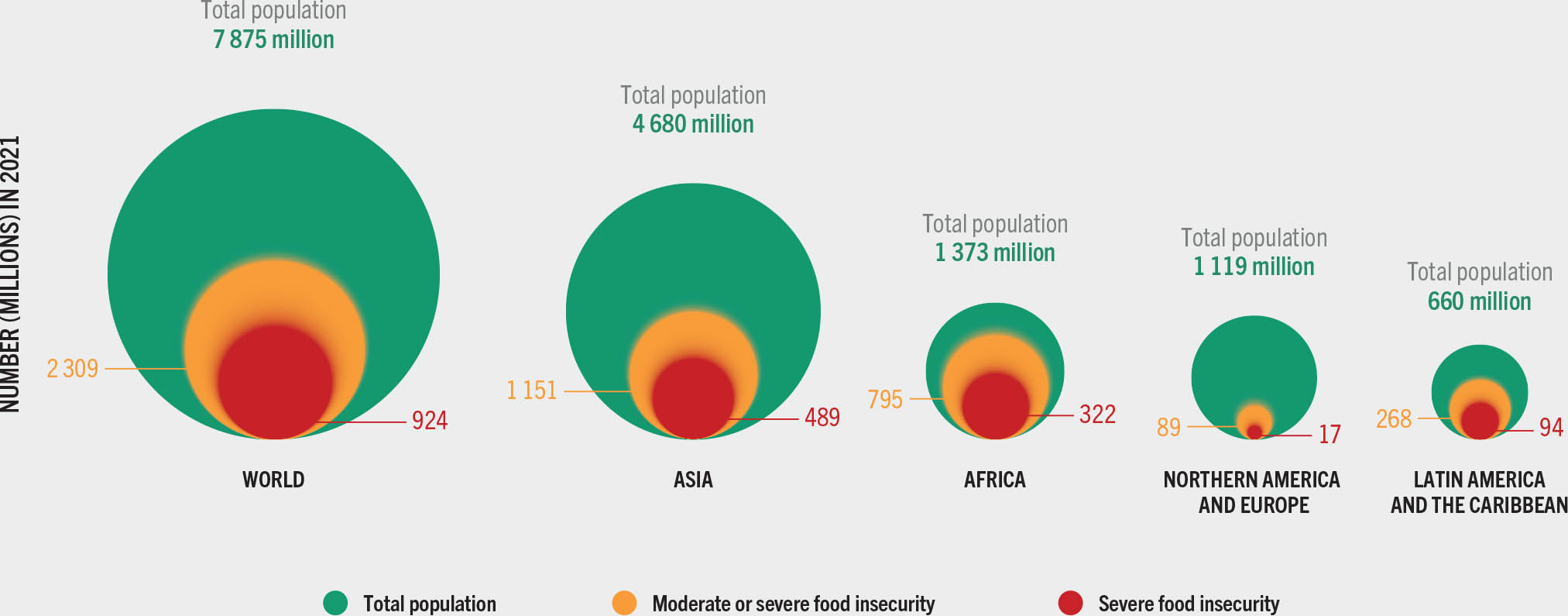
Different patterns in food-insecurity severity also emerge when countries are grouped by income level. Figure 9 shows that, as the income level falls, not only does the prevalence of food insecurity increase, but so does the proportion of severe food insecurity over the combined total of moderate or severe.
FIGURE 9As the country income level falls, the total prevalence of food insecurity and the proportion of severe food insecurity tends to increase
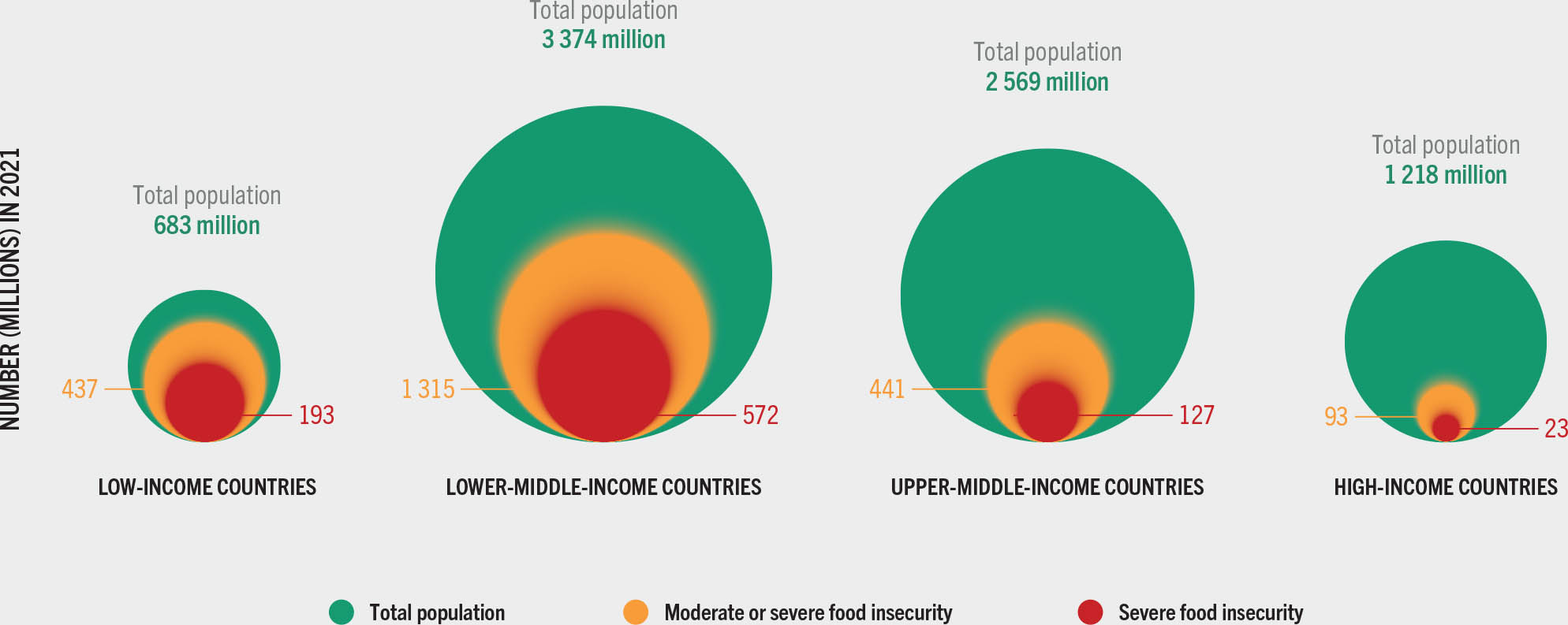
LMICs, which compose the largest portion of the global population, account for more than half the food-insecure people in the world. However, as can be seen in Figure 9, LICs suffer a much higher burden. With a combined population of only 683 million, LICs were home to 437 million food-insecure people in 2021 – 64 percent of the population of that country income group. A large proportion of these – 44 percent, or 193 million – were severely food insecure. In contrast, HICs were home to 93 million food-insecure individuals (less than 8 percent of the population of that country income group), and a smaller proportion of food-insecure people in those countries were severely food insecure: 25 percent of the total, or 23 million.
Gender differences in food insecurity
There is also a growing gender gap in food insecurity. Historically, women tend to be disproportionally affected by health and economic crises in a number of ways, including but not limited to food security and nutrition, health, time burden, and productive and economic dimensions. As mentioned earlier in this section, the COVID-19 pandemic had a disproportionate impact on women’s economic opportunities and access to nutritious foods.20
Figure 10 shows that the gender gap in the global prevalence of moderate or severe food insecurity – which had grown in 2020 under the shadow of the COVID-19 pandemic – widened even further from 2020 to 2021. In fact, in every region except Africa, food security among men actually improved while it worsened among women in every region except Asia. The increase in the gender gap globally from 2020 to 2021 was driven largely by the widening differences in Latin America and the Caribbean, as well as in Asia.
FIGURE 10Globally and in every region, the prevalence of food insecurity is higher among women than men
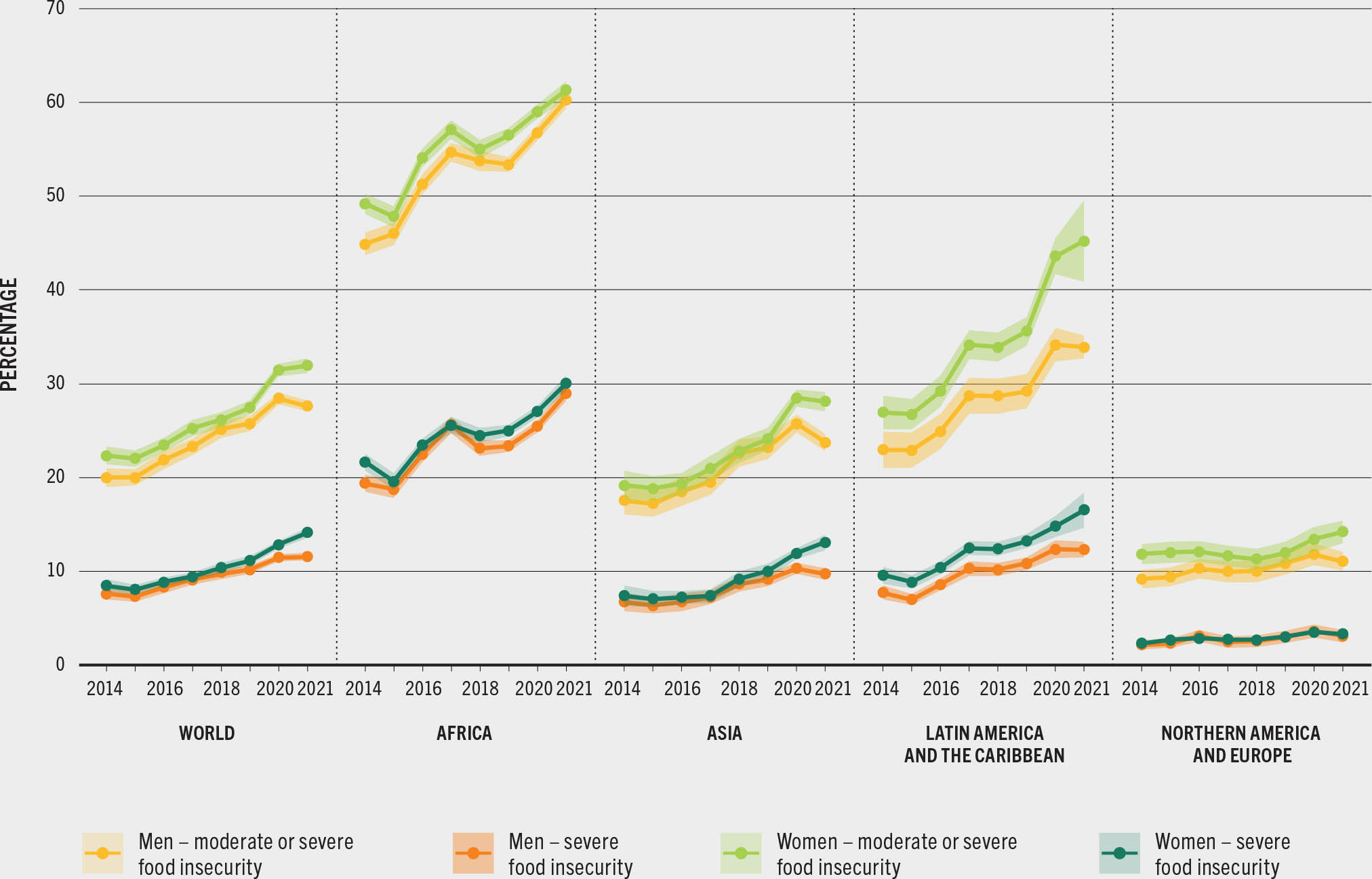
In 2021, 31.9 percent of women in the world were moderately or severely food insecure compared to 27.6 percent of men – a gap of more than 4 percentage points, compared with 3 percentage points in 2020 and 1.7 percentage points in 2019. The growing gap is most evident in Latin America and the Caribbean, where the difference between men and women was 11.3 percentage points in 2021 compared to 9.4 percentage points in 2020, and in Asia (4.4 percentage points in 2021 versus 2.7 percentage points a year earlier). The widening of the gap from 2020 to 2021 was similar for severe food insecurity. In 2021, the prevalence of severe food insecurity was 14.1 percent among women compared to 11.6 percent among men – 2.5 percentage points higher among women, compared with 1.3 percentage points in 2020.
This widening of the gender gap in food security two years in a row reflects the disproportionate impact on women of the economic crisis that was triggered by the COVID-19 pandemic and the measures implemented to contain it, mentioned earlier in this section. In addition to being more affected by job and income losses during the pandemic, women have also borne a larger burden of the additional unpaid, unrecognized caregiving, looking after sick family members and children out of school.21 Women are also often more vulnerable to food shortages and scarcity conditions in crisis situations like the pandemic because they have less access to resources, opportunities and information.
Increasing food insecurity among women in 2020 and 2021 may contribute to worsening nutritional outcomes in the short, medium and long term, including more women affected by anaemia, more babies born with low birthweight and, consequently, more malnourished children. Food security and nutrition targets will not be met without addressing gender inequalities.




